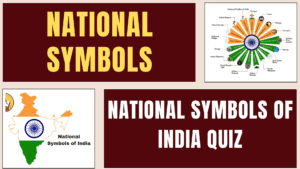8 Ultimate National Symbols Super Quiz

Q1. Consider the following statements regarding the National Flag of India:
- The Ashoka Chakra in the center of the flag has 12 spokes.
- The saffron color in the flag symbolizes courage and sacrifice.
- The National Flag was adopted by the Constituent Assembly on 26th January 1950.
Which of the statements given above is/are correct?
- (a) 1 only
- (b) 2 only
- (c) 2 and 3 only
- (d) 1, 2, and 3
Q2. With reference to the National Anthem of India, consider the following statements:
- The National Anthem was written by Bankim Chandra Chattopadhyay.
- It was first sung in the year 1911.
- It takes approximately 52 seconds to sing the complete anthem.
Which of the statements given above is/are correct?
- (a) 1 only
- (b) 2 and 3 only
- (c) 3 only
- (d) 1, 2, and 3
Q3. Consider the following statements about the National Emblem of India:
- It is an adaptation of the Lion Capital of Ashoka located at Sanchi.
- The motto “Satyameva Jayate” is inscribed at the base of the emblem.
- The National Emblem was adopted on 26th January 1950.
Which of the statements given above is/are correct?
- (a) 1 and 2 only
- (b) 2 and 3 only
- (c) 1, 2, and 3
- (d) None of the above
Q4. With reference to the National Symbols of India, consider the following pairs:
National Symbol | Declared in the Year |
1. National Aquatic Animal | 2010 |
2. National Heritage Animal | 2009 |
3. National River | 2008 |
Which of the pairs given above is/are correctly matched?
- (a) 1 only
- (b) 2 and 3 only
- (c) 1 and 3 only
- (d) 1, 2, and 3
Q5. Consider the following statements regarding the National Bird of India:
- The Indian Peafowl was declared as the National Bird in 1950.
- It symbolizes beauty, grace, and pride.
- The Indian Peafowl is scientifically classified as Pavo cristatus.
Which of the statements given above is/are correct?
- (a) 1 only
- (b) 2 and 3 only
- (c) 1, 2, and 3
- (d) None of the above
Q1. (Prelims 2013)
Which one of the following statements is correct?
- (a) The National Anthem, “Jana Gana Mana,” was first sung by Sarojini Naidu at the Calcutta Session of the Indian National Congress in 1911.
- (b) The National Song “Vande Mataram” was composed by Rabindranath Tagore.
- (c) The National Calendar of India is based on the Saka era.
- (d) The design of the National Flag of India was officially adopted by the Constituent Assembly in 1947.
Q2. (Prelims 2020)
Consider the following statements:
- The National Emblem of India is an adaptation of the Lion Capital of Ashoka.
- “Satyameva Jayate” inscribed below the Lion Capital is taken from the Bhagavad Gita.
Which of the above statements is/are correct?
- (a) 1 only
- (b) 2 only
- (c) Both 1 and 2
- (d) Neither 1 nor 2
Q3. (Prelims 2006)
What is the unique feature of the National Flag of India?
- (a) It is made of khadi.
- (b) It is hoisted only on national festivals.
- (c) It was designed by Mahatma Gandhi.
- (d) It was based on the flag of the Indian National Congress.
Q6. With reference to the National Tree of India, consider the following statements:
- The Banyan tree is a symbol of immortality and wisdom.
- It is botanically known as Ficus religiosa.
- The tree is extensively mentioned in Indian mythology and ancient texts.
Which of the statements given above is/are correct?
- (a) 1 only
- (b) 1 and 2 only
- (c) 1 and 3 only
- (d) 1, 2, and 3
Q7. With reference to the National Flower of India, consider the following statements:
- The Lotus is known for its ability to thrive in muddy waters, representing purity and resilience.
- It is associated with deities like Goddess Saraswati and Lord Vishnu.
- The botanical name of the Lotus is Nymphaea alba.
Which of the statements given above is/are correct?
- (a) 1 only
- (b) 1 and 2 only
- (c) 2 and 3 only
- (d) 1, 2, and 3
Answers:
Statement-Based Quiz:
- (b)
- (b)
- (b)
- (c)
- (b)
UPSC Previous Year Questions:
- (c)
- (a)
- (a)
- (c)
(Botanical name of the Banyan tree is Ficus benghalensis, not Ficus religiosa.) - (b)
(The botanical name of the Lotus is Nelumbo nucifera, not Nymphaea alba.)

Heartfelt congratulations
Cheers to our achievers!

UPSC CSE Courses
Comprehensive UPSC CSE Courses: Your Gateway to Civil Services Success!

UPSC Interviews
Expert Tips, Mock Sessions, Real Results

UPSC Test Series
Test Your Skills, Track Your Progress

UPSC Answer Writing
Master UPSC Answer Writing for Precision and Clarity!

UPSC PYQs
Crack UPSC with Comprehensive PYQs Practice!
National Symbols of India
India’s National Symbols represent the country’s unique identity and rich cultural heritage. These symbols play a vital role in fostering national unity and pride.
1. National Flag: Tricolour
- Description:
- Horizontal tricolour: Saffron (top), White (middle), and Green (bottom).
- In the middle, the Ashoka Chakra (navy-blue 24-spoke wheel) represents dharma.
- Adopted on: 22nd July 1947.
- Significance:
- Saffron: Courage and sacrifice.
- White: Peace and truth.
- Green: Faith and fertility.
- Ashoka Chakra: Eternal motion and progress.
- Regulation: Under the Flag Code of India.
2. National Emblem: Lion Capital of Ashoka
- Description:
- Based on the Lion Capital of the Ashokan Pillar at Sarnath.
- Four lions stand back to back; only three are visible.
- The base has a wheel (Ashoka Chakra) in the center with a bull and horse on either side.
- Motto: Satyameva Jayate (Truth Alone Triumphs), from Mundaka Upanishad.
- Adopted on: 26th January 1950.
- Significance: Reflects India’s sovereignty, cultural heritage, and values.
3. National Anthem: Jana Gana Mana
- Composer: Rabindranath Tagore.
- Adopted on: 24th January 1950.
- Duration: Approximately 52 seconds.
- Significance: Symbolizes the unity and rich heritage of India.
- First Sung: 27th December 1911, at the Calcutta session of the Indian National Congress.
4. National Song: Vande Mataram
- Author: Bankim Chandra Chattopadhyay (from his novel Anandamath).
- Adopted: Declared National Song on 24th January 1950.
- Language: Originally written in Sanskrit.
- Significance: Pays homage to the motherland.
5. National Animal: Bengal Tiger
- Scientific Name: Panthera tigris tigris.
- Significance: Represents strength, power, and grace.
- Habitat: Found in forests across India, protected under Project Tiger (1973).
6. National Bird: Indian Peafowl (Peacock)
- Scientific Name: Pavo cristatus.
- Adopted: 1963.
- Significance: Represents grace, beauty, and pride. It is often associated with Indian culture and mythology.
7. National Flower: Lotus
- Scientific Name: Nelumbo nucifera.
- Significance: Symbol of purity, spiritual enlightenment, and wealth.
- Mythological Connection: Associated with Goddess Lakshmi.
8. National Tree: Banyan Tree
- Scientific Name: Ficus benghalensis.
- Significance: Represents immortality and longevity. Sacred in Hindu mythology.
9. National Fruit: Mango
- Scientific Name: Mangifera indica.
- Significance: Known as the “King of Fruits” for its cultural and economic significance.
10. National River: Ganga
- Declared on: 2008.
- Significance: Holy river in Indian culture, symbol of purity, life, and sustenance.
11. National Currency: Indian Rupee (₹)
- Symbol Design: Created by D. Udaya Kumar.
- Significance: Combines Devanagari “₹” with the Roman “R”.
12. National Calendar: Saka Calendar
- Adopted on: 22nd March 1957 (Chaitra 1, 1879 Saka Era).
- Significance: Used alongside the Gregorian calendar.
13. National Heritage Animal: Indian Elephant
- Scientific Name: Elephas maximus indicus.
- Adopted: 2010.
- Significance: Represents biodiversity and cultural heritage.
14. National Aquatic Animal: River Dolphin
- Scientific Name: Platanista gangetica.
- Adopted: 2009.
- Significance: Found in the Ganga-Brahmaputra river systems.
15. National Reptile: King Cobra
- Scientific Name: Ophiophagus hannah.
- Significance: Represents agility and divine connections in Indian mythology.
16. National Game: Hockey
- Historically considered the national game, though no official declaration exists.
- Significance: India has a rich legacy in hockey, winning 8 Olympic gold medals.
Significance of National Symbols in Governance and Identity
- They strengthen the sense of patriotism and unity among citizens.
- They are extensively used in official documents, ceremonies, and programs to represent India.
- Violating these symbols is punishable under Indian laws such as the Prevention of Insults to National Honour Act, 1971.


